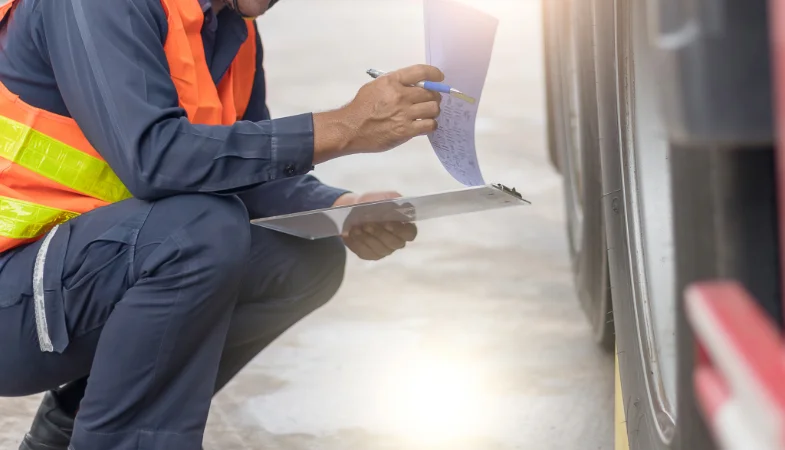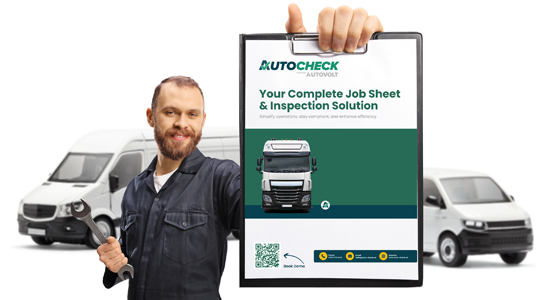Top 10 Fleet Safety Best Practices Every Operator Should Follow
Fleet safety is important because it protects your employees and others, protects your business by ensuring compliance, avoids downtime, and helps improve road safety.
The Driver & Vehicle Standards Agency (DVSA) and Traffic Commissioners expect high standards and give penalties for non-compliance. Both encourage best practice which includes high quality maintenance practices and efficient system management. Penalties can range from inconvenient to serious and, occasionally, catastrophic. People can be fined or prosecuted, and vehicles can be prohibited. If vehicles do not meet these standards, it can cause significant injury or fatalities.
Best Practices
Carry Out Daily Walk-around Checks
It is a legal requirement for a driver or designated responsible person to conduct a walk-around check of a vehicle prior to using, with at least one walk-around check being carried out in a twenty-four-hour period that the vehicle is in service. The purpose is to ensure the vehicle is free from safety defects and is roadworthy. The person conducting the check must report any defects that could prevent the safe operation of the vehicle. If any defects are found, you must not use the vehicle until it is repaired.
In addition to daily walk-around checks, drivers must monitor the roadworthiness of their vehicle whilst driving and be alert to any sign that the vehicle is developing a fault. Where more than one driver uses the vehicle during the day, each driver of the vehicle needs to make sure it is roadworthy by carrying out their own walk-around check. Any defects found during the initial walk-around check, while the subject is in use, or on its return to base, must be subjected to a written report by the person responsible for recording defects.
A robust driver defect reporting system will detail the initial walk-around check and any defects or ‘nil’ defects reported by any driver of the vehicle that day. ‘Nil’ reporting confirms that a daily check has been carried out and no defects have been found and are a useful means of checking that drivers are carrying out their duties. It is recommended that ‘nil’ defect reports are kept for at least three months, as they can also be used for audit purposes.
You can find guidance on how to carry out HGV walk-around checks and PSV walk-around checks here.
Maintain Robust Safety Inspection Schedules
Regular safety inspections are essential to an effective roadworthiness maintenance system. They form part of the overall maintenance plan of a vehicle, with the purpose of assessing items affecting roadworthiness and the environment. Regular inspections are also cost effective, as early signs of wear, damage, or maladjustment can prevent sudden failure, unscheduled downtime, or premature replacement.
Safety inspections are pre-planned, time-based inspections carried out at the frequency recorded on the vehicle operator licensing service. They should be undertaken independently from routine servicing or repair, and a maintenance scheduling system, planner, or wall chart should be used to identify inspection dates at least six months in advance. The inspection should include all the items covered by the statutory annual test, which state the minimum legal standards and should be used as guidance for the safety inspection.
Safety inspections should follow a time-based pattern, decided by assessing the level of mechanical deterioration likely to occur over a period due to the vehicle’s usage. An inspection frequency would normally range between four to thirteen weeks, depending on operating conditions:
Operating Conditions |
Frequency |
| Lightly loaded vehicles – easy operating conditions | 10-13 weeks |
| General haulage – trunking | 6-10 weeks |
| Arduous work – constant heavy loads | 4-6 weeks |
| Off-road – difficult conditions | 4 weeks |
| Vehicle/trailer 12 years or older | 6 weeks |
The inspector should also consider the frequency of inspection, age of the vehicle, expected mileage, and type of work undertaken to assess whether a part would remain in a serviceable condition before the next inspection is due. Mileage-based inspection programs may be more suitable for some operators but will need to be linked to time.
Systems of safety inspections should be regularly monitored and audited. Records must be fully completed, and the vehicle must be declared roadworthy before it returns to service. Any work carried out as a result of safety inspections must be recorded. Safety inspection and repair work records must be kept for at least fifteen months as part of a vehicle’s maintenance history.
You can find guidance on HGV inspections and PSV inspections here, and examples of safety inspection records for HGVs and trailers, PSVs, LGVs, and small trailers here.
Brake Testing & Performance Monitoring
It is expected that every safety inspection will include a brake performance assessment using either a roller brake test (RBT), a decelerometer with temperature readings, or a suitable electronic brake performance monitoring system (EBPMS).
Roller brake tests are the most effective method of measuring individual and overall braking performances. Vehicles can be presented for RBT up to fourteen days before the safety inspection date.
An approved and calibrated decelerometer can be used to measure overall brake performance values for vehicles without trailers or for vehicles that cannot be tested on an RBT, but a temperature check needs to be carried out before and after the decelerometer test to help identify if individual brakes are operational.
If using EBPMS to monitor brake performance, there must be an evaluation of the performance report before every safety inspection by someone who can interpret the data.
“Every part of every braking system and of the means of operation thereof fitted to a vehicle shall be maintained in good and efficient working order and be properly adjusted.” – Regulation 18(1) of the Road Vehicles (Construction and Use) Requirements 1986
A signed printout of the brake performance test should be attached to the safety inspection record, or the test results must be recorded by the inspector on the safety inspection report. The safety inspection record should also state the date of the assessment, how the braking performance was assessed, and whether the vehicle or trailer was laden. It is essential for brake test reports to be reviewed and understood to ensure the brakes are working correctly and meet the required standards for roadworthiness.
You can find guidance on heavy vehicle brake test best practice here.
Tyre Management
You may see on the sidewall or in the grooves of the tread pattern that tyres can deteriorate with age. This is why tyre age must be recorded and monitored for the entire fleet on the tyre management system, and tyres aged more than ten years old legally cannot be used on the front steered axles of vehicles, or as any single wheels fitted to a minibus.
- When a tyre is nine years old, this should be noted on the safety inspection
- When a tyre is over ten years old and cannot be legally used, it must be reported as a defect
- When a tyre is more than ten years old but can be legally used, their age should be recorded and a specific risk assessment should be completed that considers the distance, speed and loading conditions that the vehicle will operate under.
The tyre manufacture date code must be legible on all tyres fitted to vehicles.
Tyre pressures must be monitored, recorded as presented on the safety inspection report, and maintained to the correct pressure. Where a tyre is found to be under-inflated, this should be investigated, and any rectification action must be recorded on the safety inspection report.
Additionally, tyre tread depths must be monitored and recorded on the safety inspection report. An accurate tread depth gauge should be used to do so.
You can find advice about tyres for professional road users here.
Driver Hours Compliance & Fatigue Management
Compliance with tachograph rules regarding drivers’ hours is a critical part of an operator’s safety system, and helps to prevent fatigue-related incidents, protect public safety, and ensure fair working conditions for professional drivers.
An investigation into Onix Transcom Ltd found multiple shortcomings in the management of drivers’ hours and tachographs. A newly qualified driver had driven before his digital driver card had arrived, and positioning journeys were not recorded.
This resulted in the operator’s licence being suspended for nearly three months, the transport manager being disqualified for ten years and being required to retake the Certificate of Professional Competence before returning to the role, a driver having their vocational entitlement revoked and being disqualified from holding the entitlement for a year, and another driver being suspended for one month.
Another investigation, into Concept Scaffolding Services Ltd, found that a driver failed to insert his driver digital tachograph card, no operator licence disc was available, the vehicle unit had not been downloaded for two-thousand, six—hundred and seventy-nine days and had not been locked or downloaded by the company, and no driver card had been inserted into the vehicle unit in the preceding twenty-eight days.
The Commissioner deemed the case to fall within the serious category, and it was only on receipt of onerous undertakings that the Commissioner was able to draw back from revoking the licence and instead curtailed it for a period.
First-Use & Ad-hoc Inspections
First use and ad-hoc inspections are essential for operators who lease, hire, or borrow vehicles. These are especially important where vehicles and trailers have been out of service for some time.
Prior to using a new vehicle, operators must conduct a first use inspection to satisfy themselves that the equipment is in a roadworthy condition.
Use Competent Maintenance Providers
It is the operator’s responsibility to make sure that work is completed to a satisfactory standard, even when outsourcing maintenance work. Operators must ensure the facility being used is adequately equipped to meet these standards. The Maintenance Provision Rating Scheme (MPRS) can help by giving operators confidence in the quality of work being carried out on their vehicles.
The scheme is being managed by the Institute of Road Transport Engineers (IRTE) with support from the DVSA and Traffic Commissioners, with the aim to raise the bar for commercial vehicle maintenance, by rating workshops on staff skills and facilities. Operators will be able to find skilled maintenance providers to keep their vehicles safe to drive and be able to make more informed choices on finding a provider that suits their needs.
The MPRS will rate workshops based on staff skills, processes, and the quality of their facilities. Ratings range from ‘qualified’ for workshops with basic tools and staff skills, to ‘platinum’ for those with advanced facilities. Choosing a workshop with an MPRS rating means your vehicles are more likely to be properly maintained and less likely to get prohibitions.
You can learn more about joining the MPRS scheme here.
Leverage Telematics & Technology
Advanced Driver Assistance Systems (ADAS) provide drivers with active safety support features that use automated technology. Sensors and cameras are used to detect nearby obstacles or driver errors, and drivers can respond accordingly. Many ADAS features support safety critical systems, therefore, effective maintenance procedures are essential to ensure that they function correctly and deliver the road safety benefits they are capable of.
You can use telematics systems to monitor driver behaviour and performance. Telematics systems encourage safer practices and optimise routes based on data, resulting in a more efficient operation, as well as reduced fuel consumption.
Effective driver training can also help reduce fuel consumption. Fuel consumption is linked to vehicle emissions. Decreasing unnecessary fuel use will reduce costs and aid in the reduction of harmful emissions. There are specific risks for each fuel type, so maintenance staff and drivers must be trained and be made aware of measures to be taken in emergency situations.
Accurate Record Keeping
Drivers must report any defects promptly. Reports must be recorded, as well as details of any rectification work done. Records must be kept for at least fifteen months for all vehicles. This includes vehicles that have been removed from the operator licence or have been sold or otherwise disposed of.
Driver walk-around checks, safety inspections, first use inspections, and intermediate safety checks must be documented using either manual systems or electronic systems, or a hybrid of both.
Electronic records are acceptable, if they hold the essential information that can be made available for examination. Using an electronic vehicle maintenance system can provide effective management of all the required information including safety inspections, maintenance scheduling, and driver defect reporting.
Promote a Culture of Safety & Accountability
In order to promote a culture of safety and accountability, it is important to remember that it is a shared responsibility between drivers and operators to maintain vehicle roadworthiness.
We aim to contribute towards the culture of safety and accountability, which is why our Fleet Compliance Checklist is based on DVSA Roadworthiness Guidance and Traffic Commissioner Priorities, and details the following:
· Driver Daily Checks
· Safety Inspections & Maintenance
· Record Keeping & Documentation
· Workshops & Maintenance Providers
· Operator Licence Responsibilities
· Culture & Continuous Monitoring
You can download our Fleet Compliance Checklist here.
Conclusion
It is also important to remember that fleet safety protects your employees and others, protects your business by ensuring compliance, avoids downtime, and helps improve road safety.
You can review your current processes against DVSA standards and learn how to adopt best practices by reading the DVSA Guide to Maintaining Roadworthiness here.





